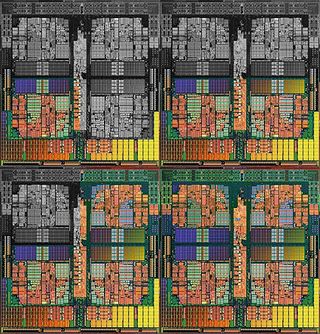First Look: AMD Triple Core Phenom
AMD Phenom With One To Four Cores Compared

2007 wasn't quite a lucky year for AMD. The firm wanted its quad core Phenom processor to compete with Intel's successful Core 2 family, which had run over AMD one and a half years ago by delivering higher performance and better energy efficiency. (This only applies to the processors, mind you; AMD has managed to stay competitive in the mainstream if you look at the entire platform.) The Phenom quad core processor, unfortunately, suffered from a nasty bug - it isn't much of an issue in desktop environments, but hurt the reputation of the fresh brand. This was particularly disappointing given that the processor arrived half a year late, and still does not reach sufficient clock speed to challenge Intel.
While this was going on, AMD had to digest the acquisition of ATI, which has certainly bound up a lot of resources as well. All of this is unfortunate, as the processor and platform market requires competition to drive innovation. Who knows where processors would be today if Intel had not had its wall back to the wall with the Pentium 4 facing fast and efficient competition from the Athlon 64 family between 2003 and 2006...
While the overall AMD appearance isn't pretty, with Phenom handicapped and Radeon graphics being a bit behind GeForce 8 in the high end, AMD does have a stand in the low-cost and mainstream segments, and the technology and strategy for the future. Its Fusion technology is expected to integrate graphics into the processor, and the design approach of the Phenom processor certainly isn't bad either. Things just haven't worked out well yet.
But let's get back to business, and have a look at the status quo and the upcoming product launches we can expect from AMD. The top priority certainly is fixing the issues with the Phenom B2 stepping, to ramp up clock speeds, and to maximize yields. One of the obvious approaches for the latter is to recycle silicon that doesn't pass the full-blown quality check and turn it into a different product with a reduced feature step. Intel goes this path by offering Core 2 Duo processors with 4 MB and 2 MB L2 cache (now also 6 MB, with 3 MB models expected in Q2) and even low-cost Pentium Dual Core and Celeron Dual Core processors, which are Core 2 dice with even less cache memory. Obviously, AMD may not only cut off flawed cache segments, but also create Phenom processors with only three or even just two cores Compare Prices on AMD Phenom Processors.
While engineering samples of the AMD Phenom triple core circulated in Taiwan earlier this year, it might still take a few weeks until they arrive on the market. However, we did not even have to get one of these to look into the performance of a Phenom triple core. All it required was an Asus M3A32-MVP Deluxe motherboard, which allows the user to select how many Phenom cores to use. We took the time and benchmarked Phenom with four, three, two and even a single core.
Join our discussion on this article!
Stay on the Cutting Edge
Join the experts who read Tom's Hardware for the inside track on enthusiast PC tech news — and have for over 25 years. We'll send breaking news and in-depth reviews of CPUs, GPUs, AI, maker hardware and more straight to your inbox.
Current page: AMD Phenom With One To Four Cores Compared
Next Page Phenom: Pros And ConsMost Popular

